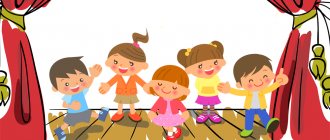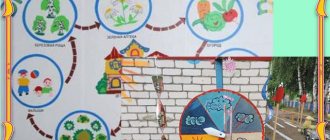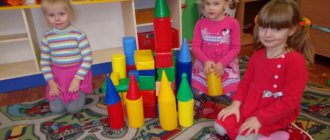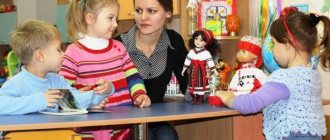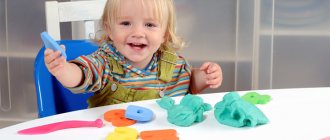Play as the main activity of preschool children
For children, one of the main activities is play. The child lives by playing. Play is an independent activity in which children actively interact with peers. Children playing are united by a common goal, common experiences that contribute to the formation of personality. In the pedagogical process, play is used as the most effective means for solving many educational problems. The game takes place in the process of development and correction of cognitive abilities, personal qualities, spatial and temporal orientations. Play is not a way of expelling excess energy, but a form of developing the free manifestation of personality. Play is a type of activity that controls development, in which not only the child’s personal qualities are formed, but also his attitude towards activities and people. [1, p.22]
We can also consider play as the main form of self-affirmation and life of preschoolers. In her works, A.P. Usova emphasized the most important function of the game, pointing out that games provide an opportunity to organize not only a certain moment in life, but also to cultivate independence, activate the passive, and provide the opportunity to act as a leader. In the game, a child gains certain experience, the opportunity to apply it in his activities, gains some knowledge and skills, can choose the theme of the game and develop a plot on this topic, can choose partners who are impressed by his type and temperament, those with whom he enjoys communicate.
I have repeatedly observed how a child sincerely perceives the game, how he lives in the game, how he cries and does not leave the game. However, in order for a child to be able to play enthusiastically and independently, he needs to be helped to learn how to play, learn to imagine and fantasize, manipulate with toys and substitute objects. As A.V. Zaporozhets noted, a child of primary preschool age needs to be helped to learn some ways of playing reality, learn to use toys, acquire the ability to act out well-known plots, learn to obey and follow the rules of the chosen game. If a child has a need, motivated by an adult, to carry out play actions and all conditions have been created for this (toys, materials, substitute objects with which children can realize this need), then the play process becomes meaningful and interesting.
While playing, the child’s emotional state improves, which is very important during the period of adaptation of children of primary school age to the conditions of kindergarten; he receives great pleasure from the game, which balances his psyche and improves his physical health.
When working with children of primary preschool age, teachers face certain tasks:
a) Relieve emotional and muscle tension, teach children to consciously perceive their own emotions - feelings and experiences - as well as understand the emotional state of others;
b) Develop skills of constructive communication with adults and peers, teach methods of successful social interaction;
c) Correct personal characteristics by stimulating the mental, emotional and psychomotor development of the child in their unity.
These tasks are solved through the main type of activity, through the play activity of the preschooler. Children need to be involved in games, to promote the development of game plots that reflect the surrounding reality and the life of the child. The games show that the baby knows what is dear to him, and develops the ability to fantasize and speak. Children learn, in accordance with the chosen role, to come up with a simple plot, build simple buildings, and independently select toys based on the theme of the game. [3, p.36]
When working with three-year-old children, you must:
- animate a game character who, during the lesson, will act as the child’s partner when completing the task and in the subsequent game;
‒ use various plots to encourage children to more complex ways of constructing a game, the transition from conditional objective actions to role-playing behavior;
- carry out the “transformation” of some objects into others, use substitute objects, etc.
In the daily routine of a preschooler, there is not much time for independent play activities, but children play constantly, play out all types of activities carried out during the day, both in kindergarten and at home. At first, already known plots are used with the kids, for example, “pretend” to bring tea, tasting the “tea” and offering to “cool it” as if it were hot, then it turns out that the tea is not sweet - you need to put sugar in the cup... this is how the plot begins with already familiar ones actions that the child repeatedly repeats with pleasure. They play out stories with pleasure with a doll - bathing, dressing, giving tea, the doll is sick, subsequently several stories are combined together, the course of the game develops, in which the teacher advises, guides and prompts. Initially, the teacher takes an active part in all games, gradually transfers the leading role to the children, promotes independence, the ability to independently build a plot and develop it.
The teacher has an active influence on the choice of the theme of the game in various ways, this could be the selection of certain toys - dishes arranged together according to purpose (dining room, tea), according to color scheme, size, a doll with clothes that are easy to put on and take off can create a desire to play “family” "; the presence of various types of building materials and animal figures can encourage the development of the plot of building pens for animals, and if you add various cars, it will be possible to build garages, etc. Including a child in a game organized by an adult is much easier than teaching him to choose a certain one on his own theme and develop the plot. The path to developing children's play should not lie through edification and suppression of children's initiative; play cannot be replaced by “action according to instructions.”
The most effective areas of work with children of primary preschool age are those that involve the active, jointly played activity of the child himself. Such activity allows him to externalize the objects of self-expression. And a child’s self-expression is a way of self-knowledge and self-development. While playing, the child’s emotional state improves, he receives great pleasure from the game, which balances his psyche and improves his physical health.
Fradkina F.I. said: “The game must be taught especially in very early childhood - this should be stated quite boldly. But you can teach in different ways. You cannot build a standard - a model that will result from the development of the plot, and impose it on a child. First of all, it won’t work, and if it does, it won’t be a game - the game will turn into an activity.” Preschool children need time to “enter” the game, so there is no need to rush them and encourage them to new actions if they have not mastered the previous ones, otherwise this leads to fatigue and an explosive situation. During the game, it is necessary to strive to ensure that the child is able to feel joy from his activity, and, importantly, from the result of his activity. A.P. Usova wrote: “Every game, if the child is capable of it, puts him in a position where his mind works vividly and energetically, his actions are organized...”
In order for the baby to grow up not only healthy, but also smart and capable, it is recommended to play with the baby literally from the moment of birth, attracting his attention to surrounding objects, teaching him to perform basic play actions “where are the ears, hands, eyes, nose, cheeks?”, by showing actions with objects, eventually suggesting the plots of games, then answering children's questions, assistance in drawing, building structures from cubes.
Ushinsky K.D. wrote “A game for a child is not a game, but a reality, it is a universal and inalienable right of a child.” For younger preschoolers, independent and organized observation of the work and everyday activities of older children and adults plays a huge role in the development of children's games. Usually, the observation is structured in such a way that the focus of attention is on the person or object being observed: the driver brought food to the kindergarten, the janitor cleans the area, the nurse examines the children, etc. Such observations help to move from playing with an object to a game in which the child plays a specific role. Children need to be shown how they can use the acquired knowledge in the game, translating it into the language of the game - highlight and distribute roles, clarify their actions according to the chosen role, think about what toys and objects are needed for this game, a sample of drawing up the plot of the game is offered.
The direct emotionality of an adult, a trusting attitude towards children, and an attitude towards toys as partners helps to sincerely captivate the child, helps to immerse children in the atmosphere of the game, and focus on the process of the game itself. Children must feel the sincere attitude of an adult towards them, then it will be possible not only to properly guide the game, but also to find a way to the child’s heart. In no case should you allow such a formulation as “Look carefully at how I play now, and then you yourself will play the same way...”. If one of the children remains completely indifferent to what is happening, he needs to be involved, offered to provide all possible assistance, “rock the doll, bring her tea, check if it’s hot? Or bring the missing bricks to build a garage or castle.
Even very young children notice the attitude of adults towards both toys and children, and then copy them, copy gestures, words, actions. Imitation becomes a playful action and gradually develops into the game itself. The plot borrowed from the teacher becomes its own, can expand and grow from the plot - the model, other toys and actions from personal relationships and experience can be added. The wider the circle of communication with older children and adults, the more information the child receives from the outside world, from the life around him, the richer the child’s games, the wider his active vocabulary. During the game itself, you can clarify and expand the acquired knowledge, complicate the content of the game, develop imagination, thinking, and enrich your vocabulary.
In younger preschoolers, specifically imaginative thinking predominates; in independent play, the child takes on a certain image, he imagines himself as a car, a kitten, a puppy, an airplane - most of all he is interested in the external side of play actions, the connection with the intention of the game is not always traced. A toy is the organizing beginning of a game; small children play with a toy; a toy can also be a partner; active action with a toy develops the imagination. When a child sees a toy, a desire arises to manipulate it, and both an idea and a plot arise. A child sees a car - he needs to go somewhere, he sees cubes - he needs to load the cubes onto the car and take them away, he sees a cup - he needs to make tea, he sees a doll - he needs to give the doll some tea. In the process of a child’s play activity with toys and objects, imagination and fantasies are manifested, and often what is desired is presented as reality. Children's fantasies can arise in certain situations. Kids enjoy playing with substitute objects. (Once the children were asked to put away the cubes, one child did not take the cubes out of his pockets, and when asked: “Why didn’t he put them away?” he answered, “There are no cubes, these are a phone and a smartphone”). Children can transfer actions from one object to another.
The correct selection of age-appropriate toys, as well as the proper arrangement of gaming material in the group room, activates play activity and promotes the development of independent play. Children of primary preschool age should have bright, medium and large household toys (dolls, bunnies, bears which are convenient to dress and undress, feed and put to bed, treat and push in a stroller, there should be playful household items: furniture, stove, irons, tablets, phones, hygiene items), etc. They should be located at the children’s eye level throughout the group room, zonally, so that children can play both individually and in small subgroups.
Kids gradually move from individual games to side-by-side games. All children have different perceptions, attention, memory, and thinking. At first, the teacher conducts simple group games “we’re going on a bus for a walk in the forest” - in the first game the teacher takes the role of the driver, the children are passengers, in subsequent games the roles can be distributed “in turns”, the kids should feel a sense of pleasure from the game and communication with other children. The plot of the game is taken from everyday life and should be familiar to young children. Children are attracted by kindness, active participation, and the desire to accept or invite the child into their play. In his work, the teacher relies on more active children, involving passive, “closed” ones in the game, paying more attention to those who adapt less well in the children's team.
The teacher must clearly remember that the level of development of the child’s play activity corresponds to the level of development of mental activity; if the child experiences difficulties in play communication, difficulties in verbal communication, closer attention to him is necessary. The main task of the teacher at this stage is to encourage children who have reached the level of “playing side by side” to play together, form and establish friendly contacts, achieve agreement in game situations, obey certain rules of the game, expand their active vocabulary, and enrich younger schoolchildren with knowledge .
Ultimately, there comes a time when systematized and generalized knowledge becomes necessary for the child’s full mental development.
The formation of play activity in young children is carried out as follows: a) teaching children to reproduce reality in a playful way, to reproduce familiar actions; b) proposal of the plot of the game, management of the game, which arises at the suggestion of the teacher and on the initiative of the children. Any coercion is categorically excluded from all techniques. The game should promote positive emotional experiences, bring joy and satisfaction; in the game the child asserts himself and develops.
Literature:
- A. V. Zaporozhets “Game and development of the child.”
- A. P. Usova “The role of play in the development of a child”
- G. M. Lyamina “Education of Young Children”
- N. S. Novoselova “Preschooler’s Game”
- T. N. Doronova “Girls and boys 3–4 years old in the family and kindergarten”
- T. B. Mazepina “Development of a child’s skills in games, trainings, tests”
Development of gaming activities
Subject. The leading role of play activity in the mental development of preschool children
| Plan: |
| 1. Thematic role-playing game is the leading activity in preschool age. |
| 2. Psychological analysis of the structure of role-playing games in different periods of preschool childhood, recommendations for developing the ability to play |
| 3. Psychological and pedagogical conditions for the development of role-playing games in preschool children. |
|
- Role-playing game is a leading activity in preschool age.
Preschool childhood is a very special period of child development. It is at this age that internal mental life and internal regulation of behavior arise. inner life manifests itself in the child’s imagination, in voluntary behavior, in communication with adults and peers. All these important qualities and abilities arise and develop in a role-playing game.
Role-playing game
- this is an activity in which children take on certain functions of adults and reproduce (or model) the actions of adults and the relationships between them in specially created playful, imaginary conditions.
That is, in role-playing game the need to be like an adult is satisfied. Role-playing is the most difficult activity that a preschool child learns. The main feature of the game is the presence of an imaginary situation.
In such a game, all the mental qualities and personality traits of the child are most intensively formed. Gaming activity influences the formation of voluntary behavior and all mental processes - from elementary to the most complex.
When playing, children concentrate better and remember more than when given direct instructions from an adult.
Play has a strong influence on the mental development of a preschooler. Acting with substitute objects, the child begins to operate in a conceivable, conventional space. The substitute object becomes a support for thinking.
Gradually, play activities are reduced, and the child begins to act internally, mentally.
Thus, the game helps the child move on to thinking in terms of images and ideas. In addition, in the game, playing different roles, the child takes on different points of view and begins to see the object from different sides. This promotes the development of the most important human thinking ability, which allows you to imagine a different view and a different point of view.
Role play is critical to developing imagination.
Game actions take place in an imaginary situation;
real objects are used as other, imaginary ones; the child takes on the roles of imaginary characters. This practice of acting in an imaginary space helps children acquire the ability to creatively imagine
.
Communication
The interaction between a preschooler and his peers also unfolds mainly in the process of playing together. While playing together, children begin to take into account the desires and actions of the other child, defend their point of view, build and implement joint plans. Therefore, play has a huge impact on the development of children’s communication during this period.
The main tasks for developing communication skills in children:
• formation of adequate ways of behavior in conflict situations
• teaching children to jointly search for mutually beneficial solutions in difficult situations;
• development of communicative competence, peer orientation, expansion and enrichment of the experience of joint activities and forms of communication with peers;
• development of skills for self-regulation of emotional states;
• development of sympathy, empathy, adequate self-esteem;
• mastering models of social behavior in role-playing games
As shown by D.B. Elkonin
, play is a historical education, and it arises when a child cannot take part in the system of social labor, because he is still too small for this. But he wants to enter adulthood, so he does this through play, having a little contact with this life.
The essence of playful transformation: a child takes on the role of another person, creates a play situation by assigning new meanings to objects and models relationships between people. Elkonin: role + replacement.
The role of play in the mental development of a child:
children learn the properties of objects and actions with them, and relationships between people;
individual mental processes are formed and developed, the child’s position in relation to the world around him changes,
the motivational-need sphere develops, the arbitrariness of mental functions develops,
the ability to empathize develops and collectivist qualities are formed, the need for recognition is satisfied (status role) and
reflection develops (this is a person’s ability to analyze his actions, actions, motives and correlate them with universal human values, as well as with the actions, actions and motives of other people).
imagination develops on the basis of external play activities; a mental plan of action is formed in the child (creating a play situation, plot planning, distribution of roles);
Thus, role-playing play is the leading activity of a preschooler and constitutes a condition for his normal mental and personal development.
2. Psychological analysis of the structure of role-playing games in different periods of preschool childhood, recommendations for developing the ability to play
Structural components of a role-playing game:
plot, content, roles, rules, game actions, game and real relationships.
Plot
- the area of reality that is reproduced in the game (the external side of the game) which the child takes from life (everyday, social);
Content
- what is reproduced as a central, characteristic moment of activity, relationships between adults, their work and social life
Roles
– a sample of socially desirable relationships, a generalized standard of behavior.
Rules
determined during the game by the children themselves;
Game actions
are mandatory components of the game (can be expressed symbolically). These are actions with meanings; they are figurative in nature. During the game, meanings are transferred from one object to another (an imaginary situation). However, this transfer is limited by the possibilities of showing the action, since it is subject to a certain rule: only an object with which it is possible to reproduce at least a picture of the action can replace an object.
Game and real relationships
Game relationships reflect the relationships between children in terms of plot and role (the daughter listens to her mother in the game). Real relationships - reflect the relationships of children as partners, comrades performing a common task, arise when roles are distributed, during the game, if the rules established by the children themselves are not followed. Game material includes toys, role attributes, and substitute objects.
Levels of development of gaming activity.
D.B. Elkonin
identified four levels of development of role-playing games.
First level:
1) actions with certain objects aimed at an accomplice in the game. This includes the actions of the “mother” or “doctor” directed towards the “child”;
2) roles are determined by action. The roles are not named, and the children in the game do not use in relation to each other the real relationships that exist between adults or between an adult and a child;
3) actions consist of repeated operations, for example, feeding with the transition from one dish to another. Apart from this action, nothing happens: the child does not replay the process of cooking, washing hands or washing dishes.
Second level:
1) the main content of the game is action with an object. But here the correspondence of the game action with the real one comes to the fore;
2) the roles are called children, and a division of functions is outlined. Fulfillment of a role is determined by the implementation of actions associated with a given role;
3) the logic of actions is determined by their sequence in reality. The number of actions is expanding.
Third level:
1) the main content of the game is action with an object. But here the correspondence of the game action with the real one comes to the fore;
2) the roles are called children, and a division of functions is outlined. Fulfillment of a role is determined by the implementation of actions associated with a given role;
3) the logic of actions is determined by their sequence in reality. The number of actions is expanding.
4) the violation of logic is protested. This is expressed in the fact that one says to the other: “It doesn’t happen like that.”
Fourth level:
1) main content - performing actions related to relationships with other people, whose roles are performed by other children;
2) roles are clearly defined and highlighted. During the game, the child adheres to a certain line of behavior. The role functions of children are interconnected. The speech is clearly role-based;
3) actions occur in a sequence that clearly recreates real logic. They are varied and reflect the richness of the actions of the person portrayed by the child;
4) violation of the logic of actions and rules is rejected. The child does not want to break the rules, explaining this by the fact that this is actually the case, as well as the rationality of the rules.
- Psychological and pedagogical conditions for the development of role-playing games in preschool children.
The main tasks faced when leading role-playing games:
1) development of the game as an activity;
2) using the game for the purpose of educating the children's team and individual children. The development of play as an activity means expanding the themes of children's games and deepening their content. In the game, children should gain positive social experience, which is why it is necessary that it reflects adults’ love of work, friendship, mutual assistance, etc. The more organized the game, the higher its educational impact. The signs of a good game are: the ability to play with concentration, purposefully, take into account the interests and desires of your comrades, resolve conflicts amicably, and help each other in difficulties.
To develop a role-playing game, a pedagogically appropriate selection of toys and gaming materials is necessary, which creates the “material basis of the game and ensures the development of the game as an activity. The selection of toys should be carried out in accordance with the main theme of children's games in a given age group, taking into account the immediate prospects for their development. For children of primary preschool age, a toy is needed that allows them to develop play in the family, kindergarten, etc. In groups of middle-aged and older children, the selection of toys should ensure the development of games on work topics and games that reflect social events and phenomena.
- The role of the teacher in the development of play in preschool children.
Leadership Techniques
Children's games can be divided into
two groups:
methods of indirect influence and methods of direct guidance.
Indirect game management
carried out by enriching children's knowledge about the surrounding social life, updating gaming materials, etc., that is, without direct intervention in the game. One of the methods of such indirect influence on children’s games is the introduction of toys and the creation of a play environment even before the start of the game. This technique is used to arouse children’s interest in a new topic of the game or to enrich the content of an existing one. The introduction of new toys arouses both playful and cognitive interest of children
Direct leadership techniques
: role-playing participation in the game, participation in the collusion of children, explanation, help, advice during the game, suggesting a new theme for the game, etc. But we must not forget that the main condition for using these techniques is the preservation and development of children’s independence in the game.
Three stages of formation of a plot-role-playing game:
On the first
stage (1.5 – 3 years), the teacher stimulates the child to carry out conventional actions with objects.
On the second
stage (3 years - 5 years) develops in children the ability to take a role, to move from one role to another in the game. This can be most successfully accomplished if you build a joint game with children in the form of a chain of role-playing dialogues between the participants, shifting the children’s attention from conventional actions with objects to role-playing speech.
On the third
stage (5-7 years old), children must master the ability to come up with a variety of game plots. To do this, the teacher can start a game together with the children - invention, which takes place in a purely speech level, the main content of which is inventing new plots that include a variety of events.
